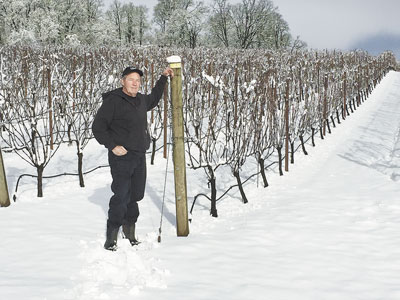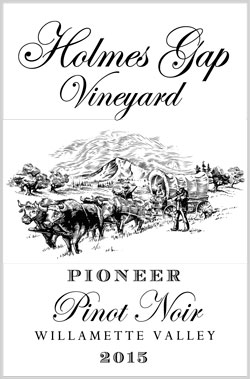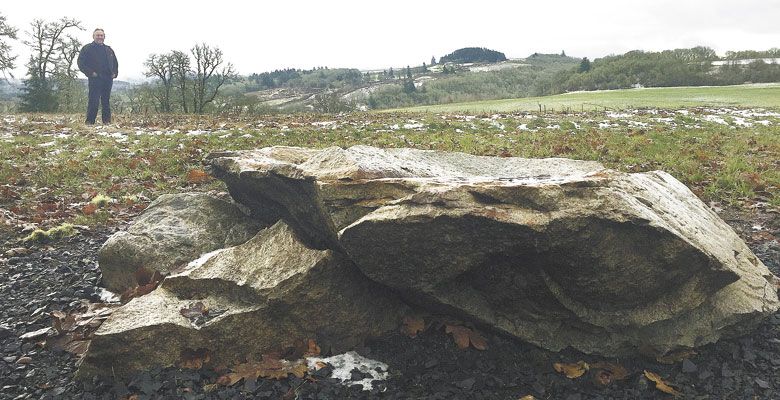Growing in The Gap
Holmes Gap Vineyard hitches wagon to history
The exposed granite boulder on Jack LaRue’s 165 acres outside Rickreall is not native to the area. Neither is Jack LaRue. Nor was Horatio Nelson Viscount Holmes.
Those two men, along with the boulder, encompass events defining the land here. LaRue moved from California 17 years ago and turned the place into a vineyard. Holmes left Virginia 170 years ago, and turned the place into a homestead. The boulder originated in what is now Montana, 15,000 years ago, along with a flood of Biblical proportions changing the Willamette Valley into a viticultural Eden.
“It was just sitting right out there,” said Jack, pointing to a spot maybe 43 feet from where it sits now. He had it moved to a prominent place hear the road, as an attraction.

Known as a glacial erratic rock, it’s one of scores of such artifacts littering the valley, having floated in while encased in prehistoric ice during the Ice Age event known as the Missoula Floods. More than 36 such floods occurred, each sending torrents of water roaring some 400 miles at an estimated rate of 380 to 400 million cubic feet per second. As Jack likes to point out, that’s about 60 times the rate of flow of the Amazon River.
When he met me at the agreed upon spot on the road to lead me to the boulder, he carried a manila folder filled with research and reports on the Missoula Floods and their impact on the area. And when he describes the flood, arm in a sweeping arc to illustrate the scope of the event, he assumes the aura of historian, pioneer and student, relating the story with a gleam in his eye.
For anyone who earns a living growing grapes and making wine, such massive geologic upheavals are hailed as catalysts for the soil conditions creating great and distinctive wines. Along with the boulders, the floods transported deposits of gravel, silt and clay. Mix that with warm air and cold winters, ladle in brisk mountain air pushed by coastal pressure, and you’ve got an alchemy of substance and conditions that keep the wine business thriving.
Holmes Gap Vineyard, in fact, is named for that other non-native we mentioned, Horatio Nelson Viscount Holmes. Born in Virginia in 1813, he moved to Illinois and married Nancy Porter in 1837. Eleven years later, the couple and their three children set out for Oregon. They settled three miles south of McCoy, according to the Polk County Museum. Holmes Gap and Holmes Hill, visible from Jack’s property, served as geographic waypoints for travelers from Portland to Salem. Holmes built a working farm and later took leadership roles in county government.

Jack enjoys this sort of thing: showcasing the history of the region, highlighting the details that make it special. Since first planting in 2006, Jack and his wife, Cheri, have grown Holmes Gap Vineyard, located on the grounds of Left Coast Cellars, to produce 40 to 50 tons of Pinot Noir and Pinot Gris each harvest. They sell their fruit to roughly 15 clients, and each year yield 1,000 cases for their own label. Working with winemaker Drew Voit at Beacon Hill Estate in Gaston, the LaRues sell in Oregon and throughout the Pacific Northwest.
Back to the boulder. We’re standing on a cleared hillside, about three acres, where Jack plans to establish rows of 777 Pinot Noir and some Chardonnay. The bitter cold and slushy rain this January afternoon go unnoticed while Jack, a rugged and well-spoken man who, after earning his MBA from Pepperdine University, spent 33 years selling large aircraft on the international market, discusses farming, ancient floods and clearing land to grow more grapes, make more wine.
“This was all Doug fir and oak,” Jack said of the hillside, explaining that in the process of having the trees cleared for planting, Matt Pihl ran into the boulder while deep ripping the compacted soil. The historical significance of the discovery is what Jack embraces with wonder and excitement.
Still, as a farmer and a vineyard manager, he’s practical as well. He’s found collections of the erratic rocks throughout his property, and while he says they can aid in soil aeration, he also adds they “become a nuisance when setting trellis poles.”
Really, it’s a charming problem for Jack, who clearly enjoys the adventure of it all, resonating the pioneer spirit clearly lingering in The Gap. A respect for this heritage is embodied in the development of their brand.
“When we started, we’d thought about reserving names like Domaine LaRue, or Chateau LaRue,” he explained. “But we decided we wanted to represent the area for its historical nature.”
The label serves as a salute to the frontier spirit as well, sporting a line drawing of a covered wagon pulled by a team of oxen with a pioneer walking alongside cradling his Hawken rifle.
While Jack clearly enjoys his new career, he never expected to retire in the Willamette Valley to grow winegrapes and make wine.
“I wanted to move to Hawaii and play golf,” he said. But being able to spend time with the grandchildren and the suggestions his wife made offered a compelling argument. Besides, he says, he’d always had an interest in winemaking.
After buying the land and building their house on a hill, Jack studied vineyard management at the Northwest Wine Studies Center at Chemeketa Community College. It was there, he says, he received his viticultural education and found a home in the wine business.
“It’s an industry where all you have to do is ask and people will help you,” he said.
That obliging spirit comes through in the form of the Willamette Valley Growers Group, the networking social club for denizens of the industry, of which Jack and Cheri are members. It’s really a social club for people who found professional success before deciding they might like to make wine. And while Holmes Gap is a distinct feature for the vineyard, it’s also directly in the path of the Van Duzer Corridor, which OWP has reported is on track to become Oregon’s newest AVA (American Viticultural Area).
“We think it’s something really special,” said Jack. And, of course, as reported, arriving at the point when Van Duzer officially becomes an AVA is no small feat. Jack worked with AVA avatar Jeff Havlin to jump through all the hoops, which included documenting meteorological data, soil samples, proving the geographic area unique, and even picking a name that reflects a recognized region.
“That’s a good thing, though,” said Jack of the rigorous qualification process. “Otherwise, you would have just anyone deciding to call their region an AVA.”
The group meets again in March, and is under orders, Jack said, to stay “on message,” regarding what they say about the new AVA and how they present it.
Once the designation becomes official, Holmes Gap and other wineries in the AVA will be poised to enjoy the resulting gravitas and marketability. Yet, his strategy has always been a focus on quality. And what he’s most excited about — at least second to the boulder — is Chardonnay.
“I think Oregon has an opportunity to do a really great Chardonnay that will be very much an Oregon Chardonnay,” he said, explaining how some winemakers have discovered clones and materials many believe hold the key for Oregon to make a distinctive white wine.
Harvesting at Holmes Gap is, for the most part, a family affair. Each year, Jack and Cheri bring in their two grown sons, Michael and David, and about a dozen seasonal employees. But Jack says they like to harvest slightly later, usually by two weeks. This, he says, adds to the flavor of the fruit.
“We don’t have a problem getting the sugars,” he said, “but I just think that letting it hang a little longer helps. And because of our size, we don’t have any trouble doing that.”
Holmes Gap Vineyard is LIVE-certified, a program of science-based standards for sustainable winegrowers. It’s one of more than 300 vineyards in the Northwest that follow LIVE’s specific guidelines with the goal of creating minimal environmental impact and using a whole-farm approach to sustainability — the entire property, including non-grape crops, landscaping, building operations, labor practices and more is monitored and certified through the program.
“You could call it healthy science,” Jack says, explaining it can be easy to simply sprinkle some fertilizer around, but his and the methodology of LIVE takes a holistic approach. This means the plants on the farm, the flowers and any chemicals are all carefully chosen. For Jack, creating the proper soil and farming environment is another aspect of winemaking.
“You can’t miss any steps,” he says. “The soil selection and how we farm are very important.”
Jack himself acknowledges that, like the boulder and Mr. Holmes, he’s just another temporary force affecting the land.
“We’re just caretakers here for some small amount of time,” he says.
Having been in the industry for more than 10 years, Jack has done little to change his eagerness to learn, as well as his sense of wonder and curiosity.
He laughs as he considers how his wife helped steer him to this cold hillside filled with vines, and explains how he still approaches it all as a student.
“Life is all about new doors and opportunity,” he says. “And you just walk through them and experience what’s on the other side.”
In the years before Neil Zawicki landed in the Willamette Valley, he spent his time as a reporter in Alaska, and a sailor with an address in a California marina. In his spare time, he’s a student of history, a painter and a guitar player.













